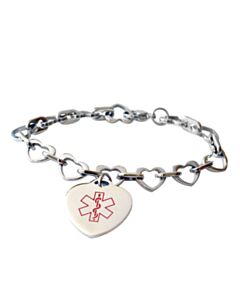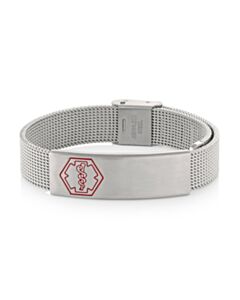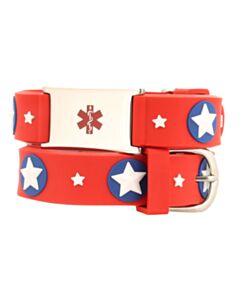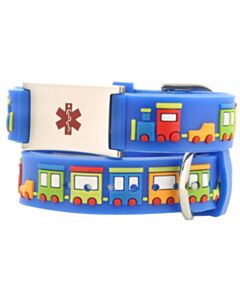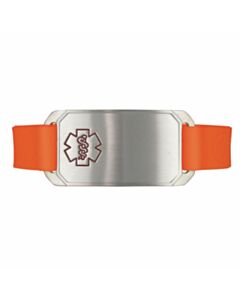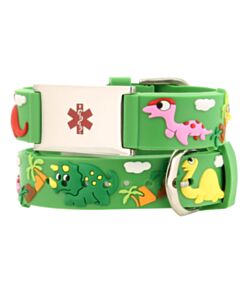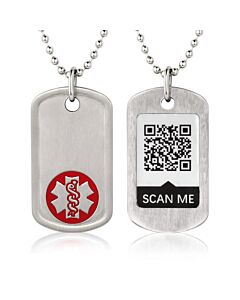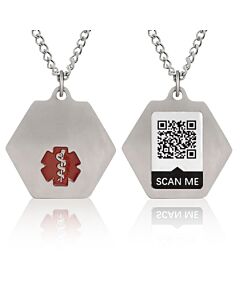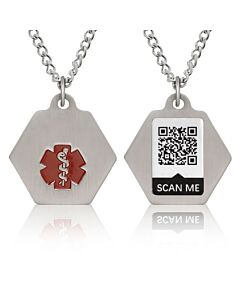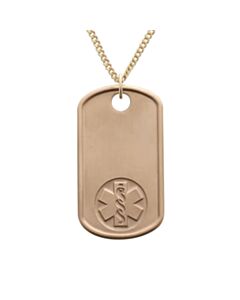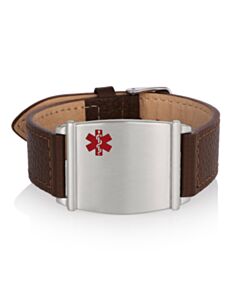

Medical IDs for Blood Thinners, Coumadin, Warfarin
Medical IDs and Blood Thinners
1. Medical conditions that may benefit from anticoagulants
2. Most Common Reaction Risks of Taking Blood Thinners
3. Communicating about Blood Thinners in an Emergency
4. Our Blood Thinner Bracelets & Wristband Options for Adults
5. Frequently Asked Questions about Medical Alert Bracelets for Blood Thinners
Each year, about 2 to 3 million people in the United States will need to take a blood thinning medication. If you or a loved one are taking anticoagulant medication, we recommend wearing a blood thinner medical bracelet or necklace to alert medical professionals in emergency situations. Blood thinners are life-saving medication that help blood flow smoothly and prevent a blood clot. This type of medication can be taken orally or administered intravenously. Anticoagulants are a type of blood thinner and examples of those commonly used are Warfarin (generic name), Coumadin, Eliquis, Xarelto, and Jantoven.
No matter how cautious a person can be of avoiding blood thinner risks, accidents can still happen and excessive bleeding can still occur in emergencies. First responders need to know if you are taking blood thinners so they can work as quickly as possible to stop any life-threatening bleeding and also, to be alerted of blood clot risks. It is important to remember that being on a blood thinner also means that there is an underlying medical condition or a history thereof – first responders need to be made aware.
Medical identification jewelry is a simple tool to effectively communicate the presence of medical conditions and medications such as blood thinners.
"Always carry or wear identification that states you are taking warfarin. In an emergency, you may not be able to speak for yourself." - Cleveland Clinic
Medical conditions that may benefit from anticoagulants
According to WebMD and JAMA Network, anticoagulants or blood thinners can help treat the following health conditions:
- Heart or blood vessel disease
- Irregular heart rhythm
- Lupus
- Deep Vein Thrombosis (DVT)
- Atrial Fibrillation
- Stroke
- Pulmonary Embolism
- Congenital Heart Defect (CHD)
Most Common Reaction Risks of Taking Blood Thinners
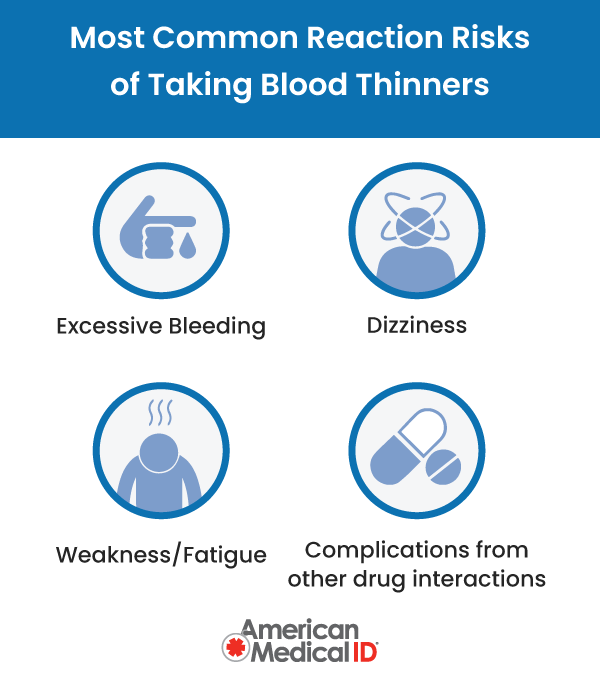

Excessive bleeding is the most common reaction when taking blood thinners. Effective management of bleeding risks is critical. Any type of trauma is extremely dangerous if you’re taking a form of blood thinner. The presence of this medication in the body can increase the risk of internal bleeding after an injury. Although infrequent, bleeding caused by blood thinners can be very serious or life-threatening.
Other side effects can include:
- Dizziness
- Weakness/Fatigue
- Complications from other drug interactions
"Another way for patients to lessen the consequences of anticoagulant-related bleeding is to wear a medical alert bracelet or carry a card in their wallet that indicates the specific anticoagulant they are taking and the dosage. This is especially important if the patient has lost consciousness or is not sufficiently cognitively aware to explain their situation to an ED physician." - Jeffrey I. Weitz, MD, FRCP(C), F
Communicating about Blood Thinners in an Emergency
No matter how cautious a person can be of avoiding blood thinner risks, accidents can still happen and excessive bleeding can still occur in emergencies. First responders need to know if you are taking blood thinners so they can work as quickly as possible to stop any life-threatening bleeding and also, to be alerted of blood clot risks. It is important to remember that being on a blood thinner also means that there is an underlying medical condition or a history thereof – first responders need to be made aware.
Medical identification jewelry is a simple tool to effectively communicate the presence of medical conditions and medications such as blood thinners.
"If you happen to be in an accident or require emergency surgery for some other reason, the warfarin will cause you to bleed more than usual. However, there are a number of ways that the effect of warfarin can be reversed and thereby prevent excessive blood loss. Obviously, those providing medical care to you in such a situation must know that you are taking warfarin in order to know that they need to reverse it." - Clot Care Online Resource
What to Engrave on a Blood Thinner Medical ID


The reasons for using blood thinning medications vary from person to person. Because of this, it is important to choose a medical ID that can be custom-engraved with the wearer’s most accurate and updated health information. This can include the following:
1. Your name to quickly identify yourself in an emergency
2. Your medical conditions or allergies
3. Specific name of medications including the brand. Examples of anticoagulants are:
- Heparin
- Warfarin (Coumadin)
- Rivaroxaban (Xarelto)
- Dabigatran (Pradaxa)
- Apixaban (Eliquis)
- Edoxaban (Savaysa)
- Enoxaparin (Lovenox)
- Fondaparinux (Arixtra)
4. Medical device or implants i.e. pacemaker or defibrillator
5. Emergency contact number. This can be your family or doctor’s contact information.
Our Blood Thinner Bracelets & Wristband Options for Adults
When shopping for an adult blood thinner wristband or medical bracelet it is important to consider the style and metal type of your daily wear medical ID. We offer blood thinner bracelets in multiple metal types such as stainless steel, sterling silver, 10K and 14K gold.
Blood Thinner Medical Alert Bracelets for Kids
Selecting a kid’s blood thinner medical alert bracelet involves proper sizing and style choice. Thankfully we offer many options in all sizes, from toddler to teenager, and many styles to choose from.
Our Blood Thinner Necklace Options
For those who prefer necklaces to bracelets, there are many available options. Shop drastically different styles ranging from durable stainless steel dog tags to elegant 14K embossed jewelry.
Best-Selling Blood Thinner Alert Jewelry
Shop our short list of top sellers, as chosen by our customers!
Frequently Asked Questions
Should I wear a medical alert bracelet for blood thinners?
Yes, you should wear a medical alert bracelet if it may alter your treatment options in an emergency. It’s very common for primary care physicians and specialist doctors to recommend medical ID jewelry when patients begin taking anticoagulant medication.
What is the medical blood thinner symbol?
Since there is no “symbol” for blood thinner or the common medications used for blood thinning, it is best to engrave the specific medication or condition. Example: “Warfarin” or “Factor V Leiden.”
A good question to ask yourself when choosing your engraving information: If a medical professional is trying to assist you in an emergency, what information is most useful for them to know to treat you correctly?
Should I still carry a blood thinner wallet card if I wear an anticoagulant bracelet?
Yes, we recommend carrying an expandable wallet card that can be used to include additional information that doesn’t always fit in the engraving space of a medical ID bracelet or necklace. Utilize your medical ID to contain the vital lifesaving information and utilize the card to document all your conditions, medications, allergies, emergency contacts, and more.


“If you take an anticoagulant, you should consider wearing a medical ID so that emergency responders and medical doctors know how to best treat you in an emergency, or if you can’t share your medical history yourself. It is important that they not only work as quickly as possible to stop any life-threatening bleeding, but also that they understand you are at risk for blood clots.” - Sara Wyen, VT and PE blood clot survivor, Blood Clot Recovery Network

 - UK
- UK  - Canada
- Canada  - Australia
- Australia 
